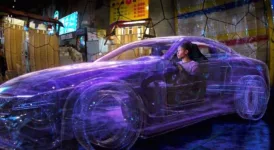I’m at NVIDIA’s GTC conference this week and I’ll be damned if their CEO Jen-Hsun Huang didn’t replicate one of the coolest technologies in the Black Panther movie. No, it wasn’t the Vibranium Armor, though that’d been really cool too, no it was the VR remote driving car technology. You recall the scene where the Black Panther’s sister, off in Wakanda, was able to take over remotely a Lexus driving it from a special remote capsule which made it feel like she was actually in the remote car?
Well Jen-Hsun showed that in NVIDIA’s lab they have created one of these things. They also showcased the car render around the driver and the driver being able to remotely drive the car. What was kind of interesting was the car that was rendered was a Lexus, and the car that was driven was a Ford. Kind of implies one of the ways to save money in the future would be to buy a cheap car but have in rendered as an expensive car. Ford would be OK with that, Lexus not so much.
But I think this suggests some really interesting things in our future.
Safe Rescue
While we will have, and NVIDIA is backing heavily, self-driving cars, self-flying aircraft, and autonomous robots it likely will be a while before these autonomous systems can deal with disasters. The reason is you have extreme conditions that will be very difficult, at least initially, to train into an AI. Maps may not work, you’ll have fires, floods, and other things that will require a far greater ability to deal with unknowns than autonomous vehicles and robots can yet deal with and, in these situations, it isn’t uncommon for a first responder, regardless of their experience, to lose their lives.
But if you could put the pilot, driver, or fire fighter into a system that would allow them to remotely control the plane, helicopter, drone, rescue vehicle, or robot you could not only respond more capably (you wouldn’t have to worry about the operator’s life) and, if there were a problem, you might lose the equipment but you wouldn’t lose a first responder.
You could certainly imagine a future where you blended these remotely operated systems with fully autonomous systems to create a far more capable, far safer, response to disasters of all kinds. The remote operators could engage from their homes or centralized offices where they worked in shifts assuring someone was ready all the time.
Response time could be cut down by minutes and the difference should allow for not only saving more lives but getting in and out of the area before the disaster progressed to a point that would make rescue far less viable.

Exploration
Using remotes to do exploration isn’t new, and it clearly advanced significantly with the emergence of high quality relatively inexpensive professional quality drones. However, someone generally has to get the drones into remote locations and deploy them often putting themselves at risk of everything from natural hazards to pirates. With this technology the explorer could remain remote and deploy the drones from a vehicle that was remotely navigated.
This could be particularly useful for schools who could co-fund the endeavor and have their students take turns exploring first hand, from the classroom, the remote location.
Law Enforcement
There have been a lot of unfortunate police shootings of late. Much of this tied to police officers who are afraid for their lives or using poor judgement. Remotes wouldn’t need to use lethal force unless it was to stop an active shooter and, even then, might be able to place their mechanical bodies in a way to shield the victims and would be far more able to restrain the alleged criminal allowing a far higher possibility of not reaching lethal force regardless of guilt.
You could have patrol cars roving autonomously but when they see a crime the remote officer could take over and even deploy a drone to arrest the perpetrator. No fear of losing their life they could exclusively use non-lethal methods of restraint. It would allow cities to do far more with far fewer officers and almost eliminate some of the huge settlements paid by the cities for some of these unfortunate deaths. More important we’d have a lot less deaths in the first place.
Military
Convoys and patrol vehicles are particularly vulnerable to mines and other types of attacks. They need to be defended and, right now, and for good reason we don’t authorize autonomous vehicles to have equally autonomous weapons systems. But you could remote the gunners using this technology and were the patrol or convoy attacked it could both defend itself and avoid any loss of live or injury because there would be no person in the convoy. Given a lot of us are concerned about what could happen if you had autonomous weapons systems, this would be a way to get much of the benefit without worrying you are creating a Terminator like outcome if the AI goes off the rails.
Racing
This seems pretty obvious, if you can take the driver out of the car you can really push the performance envelope of the car. Now we will see this with autonomous racing cars shortly but watching almost identical robots race will likely be fun once. But if you could mix up the robots with remote live drivers and allowed more variance to car design we’d likely not only get far more interesting races, but race technology might advance rapidly again.
Of course, I also think they should give the cars weapons systems to really add to the excitement but, I expect, that won’t happen.
Trucking/Package Delivery
Having a truck drive autonomously on a freeway is relatedly easy, around town not so much. The size of the vehicle provides unique problems and you want someone monitoring if there is an attempt to steal the cargo. You could have the vehicle remain autonomous until it needed to get off the freeway and then have the remote driver take over. You could also use telepresence to monitor and manage the load as well as run the robots to unload the rig remotely. UPS drivers could work in an office remotely drop the packages off on the doorstep or use the Amazon technology to put the package inside the home with full monitoring not only by the homeowner but by the truck driver. The home or business owner could have their own remote robot to accept the package and even more securely bring it inside.
Wrapping Up: Real Telepresence
I think we are finally getting to a point where telepresence can be real. We’ve been messing with it for a while, but this is the first time I’ve seen a demonstration that makes it look viable at scale. It isn’t where it needs to be yet, but the promise of going someplace without leaving your office or home is incredibly compelling. For me that is largely because I hate traveling, it sucks. But at the heart of this NVIDIA presentation wasn’t just the remote control of a car it was their Holodeck lab where they can work on stuff virtually full size. Folks can VR in and collaborate real time and they can do stuff like this remote driving demonstration. It is this Holodeck implementation that is truly compelling and, I expect, in a few short years there won’t be a product company that won’t have something like this as it would significantly speed time to market while massively reducing the costs associated with creating a product.








